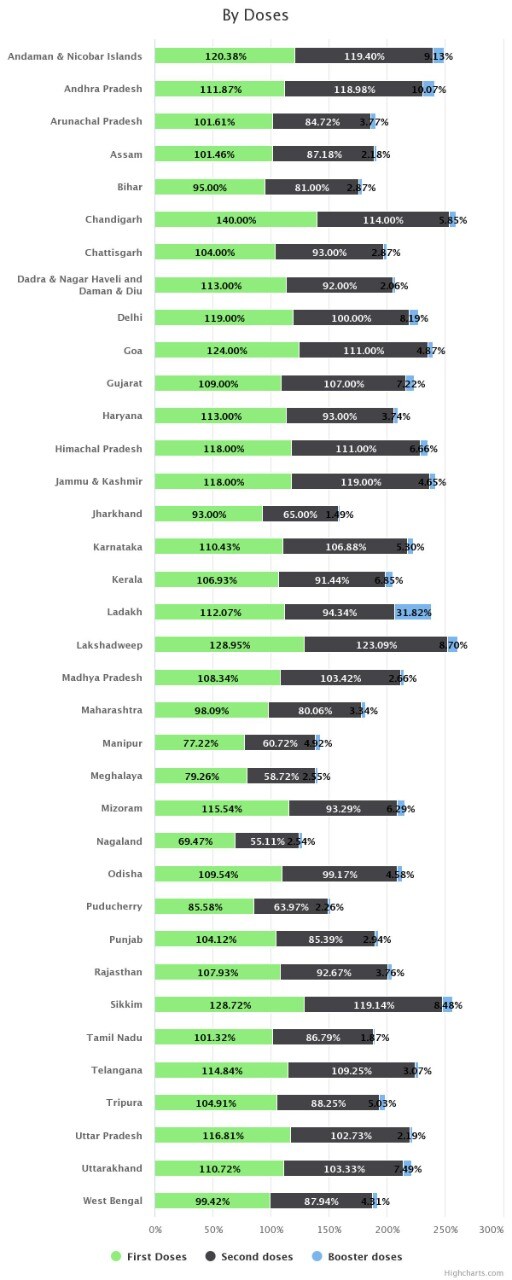The data shows that smaller states and union territories including Ladakh, Sikkim, Delhi and Lakshadweep are leading the way in coverage of booster doses.
Andhra Pradesh, Bihar, Delhi and Haryana saw the largest increase in booster doses between April 15 and June 10, according to data collected by ORF, an independent Delhi-based think tank.
The precautionary dose for the 18-59 year old category started from April 10 this year.
While uptake remains low across India, some states with relatively higher coverage of the eligible population (18+ years) with booster doses include Ladakh (31%), Andhra Pradesh (10%), Andaman and Nicobar Islands (9%) , is Lakshadweep. , Sikkim and Delhi (about 8%).
As of now, the trend among states is that with a few exceptions like Andhra Pradesh, smaller states and union territories lead in coverage of the eligible population with boosters.
Tamil Nadu and Jharkhand have the lowest coverage in the country, at less than 2% of the eligible population. Mona, who leads COVID Trackers at ORF, told News18.com, “The second dose coverage is also lagging in these states due to vaccine hesitation.” “This is a matter of concern because they have a significant proportion of the elderly (60+ years) in the population.”
What does the data reveal about other booster trends?
Overall in India, the data shows, around 15% of beneficiaries above 60 years have received the booster shot, while less than 1% of beneficiaries in the age group of 45-59 years and 18-44 years have received the shot. Is.
About half the population of health workers and frontline workers have received the shot.
top four largest states of India has not covered even 5% of its eligible population with precautionary doses.
Uttar Pradesh has so far covered only 2.19% of its eligible population with booster doses, while Madhya Pradesh, Maharashtra and Rajasthan have covered 2.66%, 3.34% and 3.76%.

Why do we need a booster shot?
The booster comes highly recommended, especially in the era of newer Omicron sub-versions like the BA4, BA5, and BA2.12.1.
For example, a study that evaluated the vaccine’s effectiveness in preventing severe COVID-19 showed that the vaccine’s effectiveness dropped from 90% to 54% during the emergence of new variants.
In comparison, the vaccine’s effectiveness was over 80% in individuals who received three doses. There is clear evidence that people who have not received a booster dose have a significantly higher risk of developing severe COVID-19 than those who have received a booster dose.
What went wrong with India’s booster rollout?
PM on December 25 Narendra Modi In India formally announced the decision to roll out a booster dose known as a precautionary dose.
However, before the government could fully implement the booster programme, a third wave led by Omicron gripped the country in January and peaked on January 21 with nearly 3.5 lakh cases a day.
Dr Libin Abrahams, research associate in the Department of Microbiology and Immunology, said: “The oomicron wave that kills too many people has led people to move away from boosters thinking they’ve already had the infection and now, another shot. There’s no need to take it.” University of British Columbia, Vancouver.
The good news is that in the Omicron wave, the population got a relatively mild infection, which eventually gave them hybrid immunity – the improved form of immunity.
Hybrid immunity is even better than immunity obtained from mix-and-match vaccines. This means that the body has gained immunity through natural infection with two doses of vaccination.
“It is a natural infection as well as a vaccine-based immunity. There is enough data to show that hybrid immunity outperforms immunity acquired through natural infection alone or through vaccine alone,” Abrahams said.
However, those who are elderly, vulnerable, have comorbid conditions or have not had a natural infection still need to take a booster dose immediately.
“Delaying a booster is bad. If these people do catch an infection, even with a mild omicron, the body may not be ready to handle a high viral load. They will be at a disadvantage because of the vaccine’s need. It may take six months or even more than a year till the final dose, which may have reduced safety,” he said.
“No more caller tunes reminding people of boosters or free booster doses for all. This shows that the government is also not as serious as before.”
According to Shinsmon Jose, a scientist and research instructor in the Department of Infectious Diseases of the College of Medicine of the University of Cincinnati, US, there are several reasons behind the slow booster dose.
First, the vaccination campaign made an error in telling what to expect from vaccines.
“While these vaccines are designed to protect people from serious diseases, the initial message wrongly indicated that the vaccines would provide complete protection against infection. It was asking to deliver more than a vaccine, especially given that we are dealing with an airborne respiratory virus with a short incubation period. ,
With new variants that can partially evade antibody-mediated protection, even vaccinated people began to become infected, reducing people’s confidence in vaccination.
“As a nation with limited resources to handle another wave, we should spend more time and effort conveying the importance of boosters.”
Other reasons for slow booster uptake include campaigns against “vaccines such as antisocial, anti-vaccine, alternative medicine practitioners, and AYUSH sympathizers, and charges for boosters in most states for people under 60.”
“After all, asymptomatic vaccination was not approved in India until last week, limiting people’s choices.”
read all breaking news , today’s fresh news watch top videos And live TV Here.